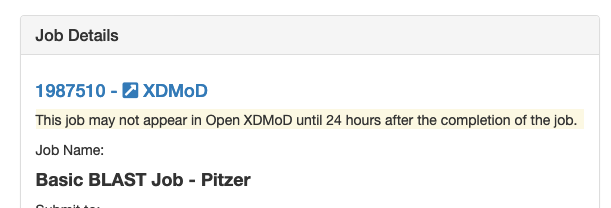Customization¶
Announcements¶
To add an announcement message that appears at the top of the dashboard you can create a file at /etc/ood/config/announcement.(md|yml) or /etc/ood/config/announcements.d/any_file_name.(md|yml).
On each request the dashboard will check for the existence of this file. If it exists, the contents will be converted using markdown converter to HTML and displayed inside a bootstrap alert.
For example, if I create an announcement.md file with the contents:
**NOTICE:** There will be a two day downtime on February 21-22, 2017. OSC OnDemand will be unavailable during this period. For details, please visit [http://bit.ly/2jhfyh7](http://bit.ly/2jhfyh7).
the user would see this message at the top of the dashboard:
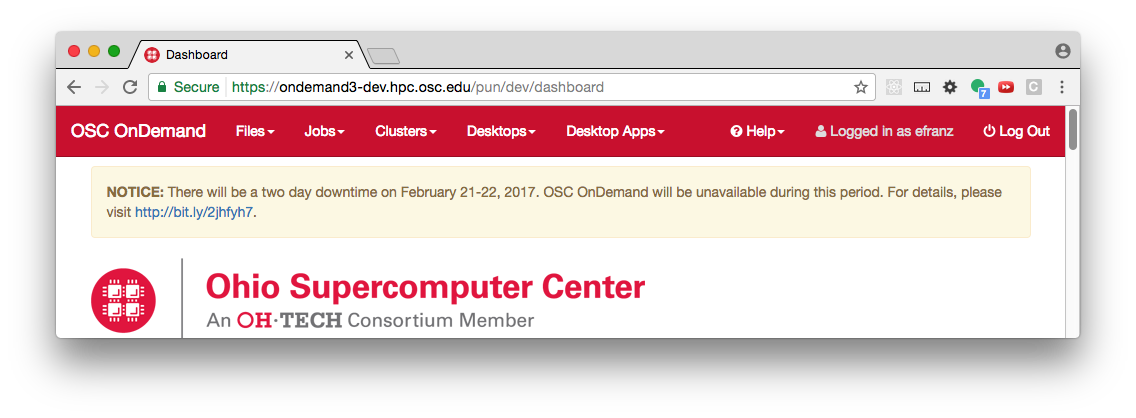
Fig. 1 Example of the Dashboard announcement.¶
If the announcement file has the extension yml and is a yaml file it is first rendered using ERB and then the resulting file is parsed as YAML. The valid keys are:
type |
warning, info, success, or danger |
this is the Bootstrap alert style |
|---|---|---|
msg |
string containing markdown formatted message |
if this is a blank string (only whitespace), the alert will not display |
Because the announcement is rendered via ERB you can do some interesting things, like stop showing the announcement past a specified date:
type: warning msg: | <% if Time.now < Time.new(2018, 9, 24, 12, 0, 0) %> A **Ruby Partial Downtime** for 4 hours on Monday, September 24 from 8:00am to 12:00pm will prevent SSH login to Ruby nodes and and Ruby VDI sessions. <% end %>
Note
Warnings about the announcement file being missing may be present in users’ nginx logs. Despite the warning the Dashboard will still function normally without those files being present.
Message of the Day (MOTD)¶
You can configure the Dashboard to display the /etc/motd file on the front page - the same file that is displayed when ssh-ing to a login node.
To display a MOTD file on the Dashboard ensure that the environment variables $MOTD_PATH and $MOTD_FORMAT are set, where
MOTD_PATH="/etc/motd" # this supports both file and RSS feed URIs MOTD_FORMAT="txt" # markdown, txt, rss, markdown_erb, txt_erb
Tip
The _erb formats support ERB rendering to generate more dynamic messages.
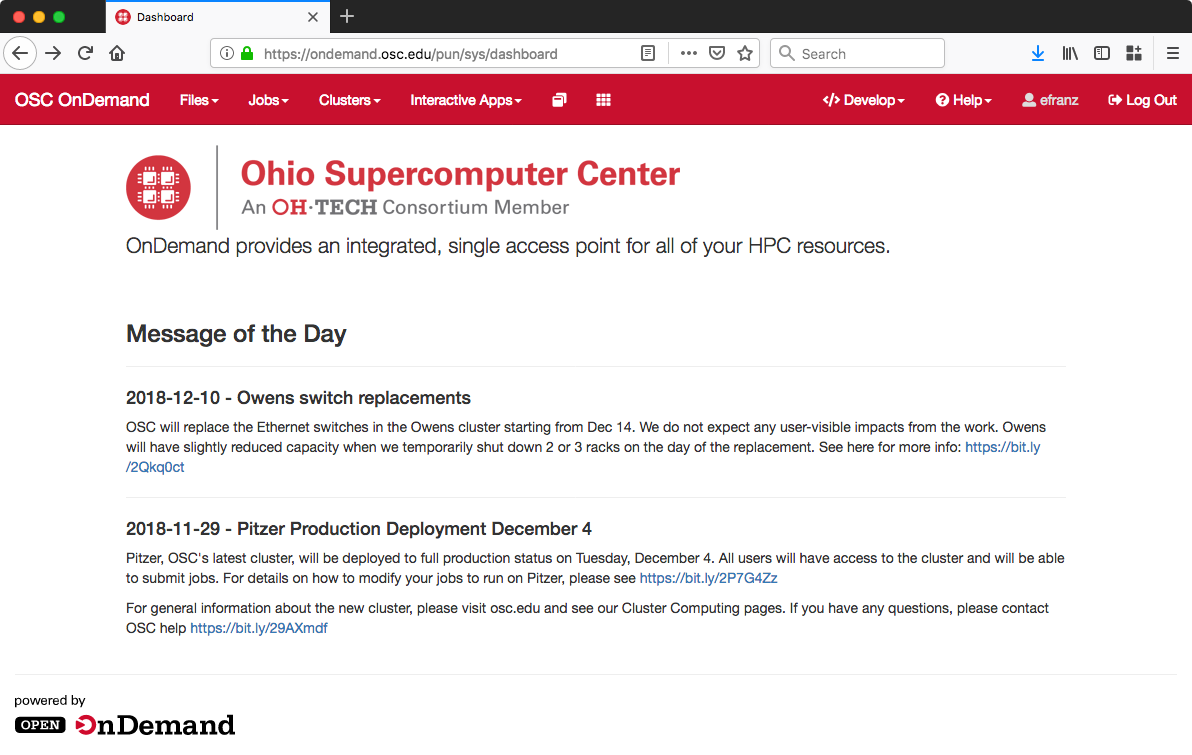
Fig. 2 Message of the Day appears in the body of the index page.¶
We recommend setting this in /etc/ood/config/apps/dashboard/env.
Branding¶
You can customize the logo, favicon, title, and navbar colors of OnDemand.
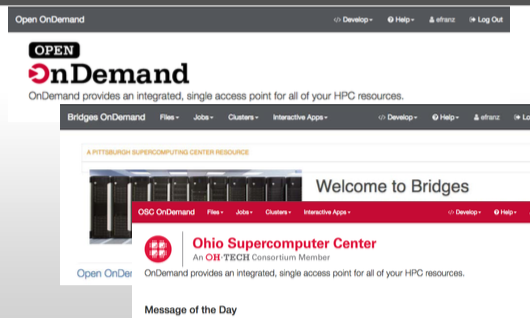
We recommend setting these environment variables in /etc/ood/config/nginx_stage.yml as YAML mappings (key value pairs) in the mapping (hash/dictionary) pun_custom_env. Alternatively you can set these in the env files of the dashboard and the apps. Currently only the dashboard uses the colors in the navbar.
Feature |
Environment Variable |
Details |
|---|---|---|
Title |
OOD_DASHBOARD_TITLE |
The title appears in the navbar and is controlled by the environment variable |
Logo |
OOD_DASHBOARD_LOGO |
The default value for |
Logo height |
OOD_DASHBOARD_LOGO_HEIGHT |
The CSS height of the dashboard logo. |
Favicon |
OOD_PUBLIC_URL |
The favicon is expected to exist at the path |
Brand background color |
OOD_BRAND_BG_COLOR |
Controls the background color of the navbar in the dashboard |
Brand foreground color |
OOD_BRAND_LINK_ACTIVE_BG_COLOR |
Controls the background color the active link in the navbar in the dashboard |
Replace header title with logo |
OOD_DASHBOARD_HEADER_IMG_LOGO |
Value should be url to logo i.e. |
Use white text on black background for navbar. |
OOD_NAVBAR_TYPE |
By default we use |

Fig. 3 Nav bar if I set OOD_BRAND_BG_COLOR to #0000ff and OOD_BRAND_LINK_ACTIVE_BG_COLOR to #ff0000 and OOD_DASHBOARD_TITLE to OSC OnDemand¶
Warning
If setting in nginx_stage.yml, careful to set the value using quotes i.e. OOD_BRAND_BG_COLOR: '#0000ff'. If you omit the quotes, YAML will see # as a comment and the value of the OOD_BRAND_BG_COLOR will be nil
Set Upload Limits¶
By default, the file size upload limit is 10737420000 bytes (~10.7 GB).
If you want set this to a lower value, set the FILE_UPLOAD_MAX configuration
in the file apps’ configuration file /etc/ood/config/apps/shell/env.
If you want to set it to a higher value set nginx_file_upload_max
in /etc/ood/config/nginx_stage.yml to the desired value. If you have
FILE_UPLOAD_MAX set from above, unset it.
If the values differ, the files app will choose the smaller of the two as the maximum upload limit.
Warning
Both of these configurations are expected to be numbers only (no characters) and in units of bytes. The default value of 10737420000 bytes is ~10.7 GB or ~10.0 Gib.
Values like 1000M or 20G will not be accepted and may cause errors.
If you want to disable file upload altogether, set FILE_UPLOAD_MAX to 0 and leave
the nginx_file_upload_max configuration alone (or comment it out so the default
is used).
Block or Allow Directory Access¶
By default, all directories are open and accessible through Open OnDemand (barring POSIX file permissions. Open OnDemand can never read files the user cannot read).
By setting a colon delimited OOD_ALLOWLIST_PATH environment variable, the Job Composer, File Editor, and Files app respect the allowlist in the following manner:
Users will be prevented from navigating to, uploading, downloading, viewing, or editing files that are not an eventual child of the allowlisted paths
Users will be prevented from copying a template directory from an arbitrary path in the Job Composer if the arbitrary path that is not an eventual child of the allowlisted paths
Users should not be able to get around this using symlinks
We recommend setting this environment variable in /etc/ood/config/nginx_stage.yml as a YAML mapping (key value pairs) in the mapping (hash/dictionary) pun_custom_env i.e. below would whitelist home directories, project space, and scratch space at OSC:
pun_custom_env:
OOD_ALLOWLIST_PATH: "/users:/fs/project:/fs/scratch"
Warning
This is not yet used in production at OSC, so we consider this feature “experimental” for now.
Warning
This allowlist is not enforced across every action a user can take in an app (including the developer views in the Dashboard). Also, it is enforced via the apps themselves, which is not as robust as using cgroups on the PUN.
Set Default SSH Host¶
Warning
The shell app does not work out of the box because all SSH hosts have to be explicitly allowed through the allowlist (see the section below).
Because there are no hosts configured, no hosts are allowed.
In /etc/ood/config/apps/shell/env set the env var OOD_DEFAULT_SSHHOST to change the default ssh host.
Since 1.8, there is no out of the box default (in previous versions it was ‘localhost’, but this has been removed).
This will control what host the shell app ssh’s to when the URL accessed is /pun/sys/shell/ssh/default which is the URL other apps will use (unless there is context to specify the cluster to ssh to).
Since 1.8 you can also set the default ssh host in the cluster configuration as well. Simply add default=true attribute to the login section like the example below.
# /etc/ood/config/clusters.d/my_cluster.yml
---
v2:
metadata:
title: "My Cluster"
login:
host: "my_cluster.my_center.edu"
default: true
Set SSH Allowlist¶
In 1.8 and above we stopped allowing ssh access by default. Now you have explicitly set what hosts users will be allowed to connect to in the shell application.
Every cluster configuration with v2.login.host that is not hidden (it has
v2.metadata.hidden attribute set to true) will be added to this allowlist.
To add other hosts into the allow list (for example compute nodes) add the configuration
OOD_SSHHOST_ALLOWLIST to the /etc/ood/config/apps/shell/env file.
This configuration is expected to be a colon (:) separated list of GLOBs.
Here’s an example of of this configuration with three such GLOBs that allow for shell access into any compute node in our three clusters.
# /etc/ood/config/apps/shell/env
OOD_SSHHOST_ALLOWLIST="r[0-1][0-9][0-9][0-9].ten.osc.edu:o[0-1][0-9][0-9][0-9].ten.osc.edu:p[0-1][0-9][0-9][0-9].ten.osc.edu"
Shell App SSH Command Wrapper¶
Since OOD 1.7 you can use an ssh wrapper script in the shell application instead of just the ssh command.
This is helpful when you pass add additional environment variable through ssh (-o SendEnv=MY_ENV_VAR) or ensure some ssh command options be used.
To use your ssh wrapper configure OOD_SSH_WRAPPER=/usr/bin/changeme to point to your script in /etc/ood/config/apps/shell/env. Also be sure to make your script executable.
Here’s a simple example of what a wrapper script could look like.
#!/bin/bash
args="-o SendEnv=MY_ENV_VAR"
exec /usr/bin/ssh "$args" "$@"
Fix Unauthorized WebSocket Connection in Shell App¶
If you see a 401 error when attempting to launch a Shell app session, where the request URL starts with wss:// and the response header includes X-OOD-Failure-Reason: invalid origin, you may need to set the OOD_SHELL_ORIGIN_CHECK configuration option.
There is a security feature that adds proper CSRF protection using both the Origin request header check and a CSRF token check.
The Origin check uses X-Forwarded-Proto and X-Forwarded-Host that Apache mod_proxy sets to build the string that is used to compare with the Origin request header the browser sends in the WebSocket upgrade request.
In some edge cases this string may not be correct, and as a result valid WebSocket connections will be denied. In this case you can either set OOD_SHELL_ORIGIN_CHECK env var to the correct https string, or disable the origin check altogether by setting OOD_SHELL_ORIGIN_CHECK=off (or any other value that does not start with “http”) in the /etc/ood/config/apps/shell/env file.
Either way the CSRF token will still provide protection from this vulnerability.
# /etc/ood/config/apps/shell/env
# to disable it, just configure it with something that doesn't start with http
OOD_SHELL_ORIGIN_CHECK='off'
# to change it simply specify the http(s) origin you want to verify against.
OOD_SHELL_ORIGIN_CHECK='https://my.other.origin'
Custom Job Composer Templates¶
Below explains how job templates work for the Job Composer and how you can add your own. Here is an example of the templates we use at OSC for the various clusters we have
Job Templates Overview¶
“Job Composer” attempts to model a simple but common workflow. When creating a new batch job to run a simulation a user may:
copy the directory of a job they already ran or an example job
edit the files
submit a new job
“Job Composer” implements these steps by providing the user job template directories and the ability to make copies of them: (1) Copy a directory, (2) Edit the files, and (3) Submit a new job.
Copy a directory of a job already ran or an example job
User can create a new job from a “default” template. A custom default template can be defined at
/etc/ood/config/apps/myjobs/templates/defaultor under the app deployment directory at/var/www/ood/apps/sys/myjobs/templates/default. If no default template is specified, the default is/var/www/ood/apps/sys/myjobs/example_templates/torqueuser can select a directory to copy from a list of “System” templates the admin copied to
/etc/ood/config/apps/myjobs/templatesor under the app deployment directory at/var/www/ood/apps/sys/myjobs/templatesduring installationuser can select a directory to copy from a list of “User” templates that the user has copied to
$HOME/ondemand/data/sys/myjobs/templatesuser can select a job directory to copy that they already created through “Job Composer” from
$HOME/ondemand/data/sys/myjobs/projects/default
Edit the files
user can open the copied job directory in the File Explorer and edit files using the File Editor
Submit a new job
user can use the Job Options form specify which host to submit to, what file is the job script
user can use the web interface to submit the job to the batch system
after the job is completed, the user can open the directory in the file explorer to view results
Job Template Details¶
A template consists of a folder and a manifest.yml file.
The folder contains files and scripts related to the job.
The manifest contains additional metadata about a job, such as a name, the default host, the submit script file name, and any notes about the template.
name: A Template Name
host: ruby
script: ruby.sh
notes: Notes about the template, such as content and function.
In the event that a job is created from a template that is missing from the manifest.yml, “Job Composer” will assign the following default values:
nameThe name of the template folder.hostThe cluster id of the first cluster with a valid resource_mgr listed in the OOD cluster configscriptThe first.shfile appearing in the template folder.notesThe path to the location where a template manifest should be located.
Job Composer Script Size Limit¶
Since 1.7 the Job composer shows users ‘Suggested file(s)’ and ‘Other valid file(s)’. Other valid files are
_any_ files less than OOD_MAX_SCRIPT_SIZE_KB which defaults to 65 (meaning 65kb).
To reconfigure this, simply set the environment variable in the job composers’ env file
/etc/ood/config/apps/myjobs/env like so:
# show any file less than or equal to 15 kb
OOD_MAX_SCRIPT_SIZE_KB=15
Custom Error Page for Missing Home Directory on Launch¶
Some sites have the home directory auto-create on first ssh login, for example
via pam_mkhomedir.so. This introduces a problem if users first access the system
through OnDemand, which expects the existence of a user’s home directory.
In OnDemand <= 1.3 if the user’s home directory was missing a non-helpful single
string error would display. Now a friendly error page displays. This error page
can be customized by adding a custom one to /etc/ood/config/pun/html/missing_home_directory.html.
The default error page looks like this:

An example of a custom error page has been provided at /opt/ood/nginx_stage/html/missing_home_directory.html.example.pam_mkhomedir and can be copied to /etc/ood/config/pun/html/missing_home_directory.html. This example directs the user to first click a link to open the shell app which will create the home directory. The shell app’s default host must be configured to be a host that is appropriate for this purpose. The custom error page looks like this:
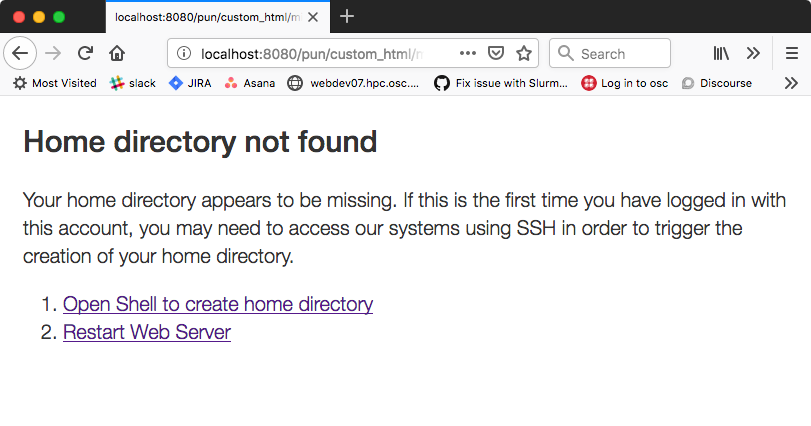
See this Discourse discussion for details.
Pinning Applications to the Dashboard¶
In version 2.0 you can now pin app Icons to the dashboard that link to the application form.
When configured a widget like the one below will appear on the dashboard’s landing page.
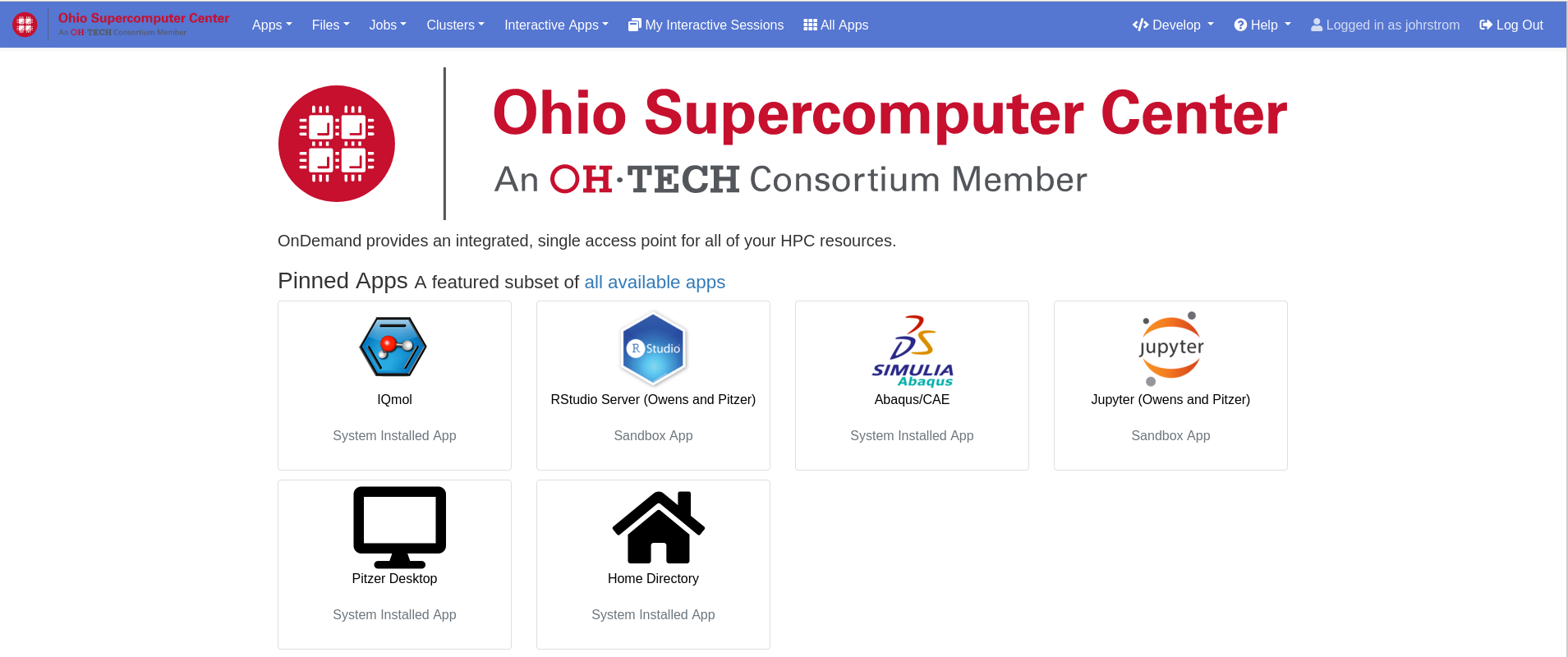
The configuration for what apps to pin allows for three variants.
You can configure specific apps with a string of the type router/app_name.
For example sys/jupyter is the system installed app named jupyter.
Secondly you can configure globs like sys/* to pin all system installed apps. Or
Maybe sys/minimal_* to pin all system installed apps that being with ‘minimal’.
Lastly you can choose to pin apps based off of fields in their manifest.yml file.
You can match by type, category, subcategory and metadata fields. These matches are
cumulative. Meaning an app has to match all of these to be pinned. In the examples below
there is a configuration of type sys and category minimal. This configuration will only pin
system installed apps that are in the minimal category. An app has to meet both these
criteria to be pinned to the dashboard.
Full examples are below:
# /etc/ood/config/ondemand.d/ondemand.yml
pinned_apps:
- sys/jupyter # pin a specific system installed app called 'jupyter'
- 'sys/*' # pin all system install apps. This also works for usr/* and dev/*
- category: 'minimal' # pin all the apps in the 'minimal' category
- type: sys # pin all system installed apps in the minimal category.
category: 'minimal'
# pin all system installed apps in the minimal category and the
# class instruction subcategory
- type: sys
category: 'minimal'
subcategory: 'class_instruction'
# pin all system installed apps in the minimal category, the
# class instruction subcategory and the metadata field 'field_of_science'
# with an exact match on biology
- type: sys
category: 'minimal'
subcategory: 'class_instruction'
field_of_science: 'biology'
# pin any app with an exact match on the metadata field_of_science of biology
- field_of_science: 'biology'
# pin any app with an glob match *bio* on the metadata field_of_science
- field_of_science: '*bio*'
Administrators can also configure the pinned apps to be grouped by any field
in the manifest.yml including metadata fields with the pinned_apps_group_by
configuration.
This will create a row and a heading for each group like so (the image was generated from grouping by category):
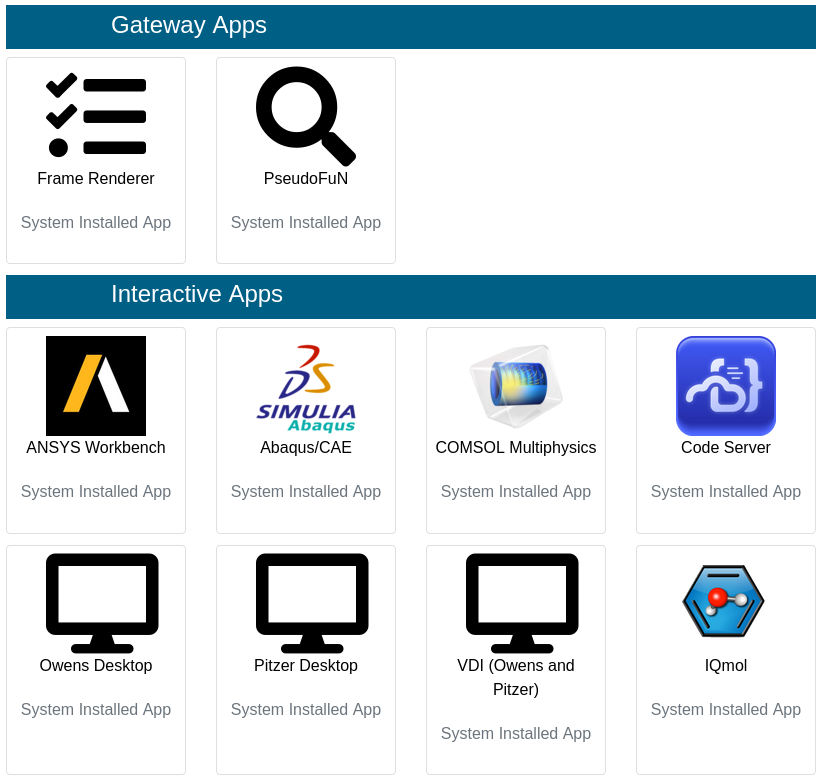
One can also change the menu length in the ‘App’s menu item. If you’ve pinned more than 6 apps and you want to them to show up in this dropdown list, simply increase the length with the option below.
# /etc/ood/config/ondemand.d/ondemand.yml
pinned_apps_menu_length: 6 # the default number of items in the dropdown menu list
pinned_apps_group_by: category # defaults to nil, no grouping
Custom layouts in the dashboard¶
Administrators can now customize what widgets appear on the dashboard and how they’re layed out on the page.
In it’s simplest form this feature allows for a rearrangement of existing widgets. As of 2.0 the existing widgets are:
pinned_apps- Pinned apps described abovemotd- the Message of the Dayxdmod_widget_job_efficiency- the XDMoD widget for job efficiencyxdmod_widget_jobs- the XDMoD widget for job information
This feature also allows for administrators to add custom widgets.
Simply drop new files into /etc/ood/config/apps/dashboard/views/widgets and reference them
in the configuration. These partial files can be any format Rails recognizes, notably .html or
.html.erb extensions.
Also if you use subdirectories under widgets, they can be referenced by relative paths. For example
views/widgets/cluster/_my_cluster_widget.html.erb would be referenced in the configuration
as cluster/my_cluster_widget.
Warning
Rails expects files to be prefixed with an underscore. For example if you configured my_new_widget
the filename should be _my_new_widget.html.
Without setting this configuration, the dashboard will arrange itself depending on what features are enabled. For example if both pinned apps and XDMoD features are enabled it will arrange itself accordingly based on a default layout.
Here’s the default configuration when all of these features are enabled.
# /etc/ood/config/ondemand.d/ondemand.yml
dashboard_layout:
rows:
- columns:
- width: 8
widgets:
- pinned_apps
- motd
- width: 4
widgets:
- xdmod_widget_job_efficiency
- xdmod_widget_jobs
rows are an array of row elements. Each row element has a columns field which is an array
column elements. Each column element two fields. A width field that specifies the width in the
bootstrap grid layout which defaults to 12 columns in total. It also has a widgets field which
is an array of existing or newly added widgets to render in that column.
Customize Text in OnDemand¶
Using Rails support for Internationalization (i18n), we have internationalized many strings in the Dashboard and the Job Composer apps.
Initial translation dictionary files with defaults that work well for OSC and using the English locale (en) have been added (/var/www/ood/apps/sys/dashboard/config/locales/en.yml and /var/www/ood/apps/sys/myjobs/config/locales/en.yml). Sites wishing to modify these strings in order to provide site specific replacements for English, or use a different locale altogether, should do the following:
Copy the translation dictionary file (or create a new file with the same structure of the keys you want to modify) to
/etc/ood/config/locales/en.ymland modify that copy.If you want apps to look for these dictionary files in a different location than
/etc/ood/config/locales/en.ymlyou can change the location by definingOOD_LOCALES_ROOTenvironment variable.The default locale is “en”. You can use a custom locale. For example, if you want the locale to be French, you can create a
/etc/ood/config/locales/fr.ymland then configure the Dashboard to use this locale by setting the environment variableOOD_LOCALE=frwhere the locale is just the name of the file without the extension. Do this in either the nginx_stage config or in the Dashboard and Job Composer env config file.
In each default translation dictionary file the values that are most site-specific (and thus relevant for change) appear at the top.
File path |
App |
Translation namespace |
|---|---|---|
|
|
|
|
|
|
|
All localizable apps will check this path, unless |
Any |
Warning
Translations have certain variables passed to them for example %{support_url}. Those variables may be used or removed from the translation. Attempting to use a variable that is not available to the translation will crash the application.
Note
Localization files are YAML documents; remember that YAML uses spaces for indentation NOT tabs per the YAML spec.
Note
OnDemand uses the convention that translations that accept HTML with be suffixed with _html. Any other translation will be displayed as plain text.
Change the Dashboard Tagline¶
en:
dashboard:
welcome_html: |
%{logo_img_tag}
<p class="lead">OnDemand provides an integrated, single access point for all of your HPC resources.</p>
motd_title: "Message of the Day"
The welcome_html interpolates the variable logo_img_tag with the default
logo, or the logo specified by the environment variable OOD_DASHBOARD_LOGO.
You may omit this variable in the value you specify for welcome_html if you prefer.
Change quota messages in the Dashboard¶
Two messages related to file system usage that sites may want to change:
quota_additional_message- gives the user advice on what to do if they see a quota warning
quota_reload_message- tells the user that they should reload the page to see their quota usage change, and by default also tells users that the quota values are updated every 5 minutes
Customize Text in the Job Composer’s options form¶
The OSC-default value for options_account_help says that the account field is optional unless a user is a member of multiple projects.
Items of note include what to call Accounts which might also be Charge Codes, or Projects. At OSC entering an account is optional unless a user is a member of multiple projects which is reflected in the default value for the string options_account_help.
Disk Quota Warnings on Dashboard¶
You can display warnings to users on the Dashboard if their disk quota is nearing its limit. This requires an auto-updated (it is recommended to update this file every 5 minutes with a cronjob) JSON file that lists all user quotas. The JSON schema for version 1 is given as:
{
"version": 1,
"timestamp": 1525361263,
"quotas": [
{},
{}
]
}
Where version defines the version of the JSON schema used, timestamp
defines when this file was generated, and quotas is a list of quota objects
(see below).
You can configure the Dashboard to use this JSON file (or files) by setting the
environment variable OOD_QUOTA_PATH as a colon-delimited list of all JSON
file paths in the /etc/ood/config/apps/dashboard/env file. In addition to
pointing to files OOD_QUOTA_PATH may also contain HTTP(s) or FTP protocol
URLs. Colons used in URLs are correctly handled and are not treated as delimiters.
Warning
Sites using HTTP(s) or FTP for their quota files may see slower dashboard load times, depending on the responsiveness of the server providing the quota file(s).
The default threshold for displaying the warning is at 95% (0.95), but this
can be changed with the environment variable OOD_QUOTA_THRESHOLD.
An example is given as:
# /etc/ood/config/apps/dashboard/env
OOD_QUOTA_PATH="/path/to/quota1.json:https://example.com/quota2.json"
OOD_QUOTA_THRESHOLD="0.80"
Individual User Quota¶
If the quota is defined as a user quota, then it applies to only disk
resources used by the user alone. This is the default type of quota object and
is given in the following format:
Warning
A block must be equal to 1 KB for proper conversions.
Individual Fileset Quota¶
If the quota is defined as a fileset quota, then it applies to all disk
resources used underneath a given volume. This requires the object to be
repeated for each user that uses disk resources under this given volume.
The format is given as:
{
"type": "fileset",
"user": "user1",
"path": "/path/to/volume2",
"block_usage": 500,
"total_block_usage": 1000,
"block_limit": 2000,
"file_usage": 1,
"total_file_usage": 5,
"file_limit": 10
}
Where block_usage and file_usage are the disk resource usages attributed to
the specified user only.
Note
For each user with resources under this fileset, the above object will be repeated with just user, block_usage, and file_usage changing.
Balance Warnings on Dashboard¶
You can display warnings to users on the Dashboard if their resource balance is nearing its limit. This requires an auto-updated (it is recommended to update this file daily with a cronjob) JSON file that lists all user balances. The JSON schema for version 1 is given as:
{
"version": 1,
"timestamp": 1525361263,
"config": {
"unit": "RU",
"project_type": "project"
},
"balances": [
{},
{}
]
}
Where version defines the version of the JSON schema used, timestamp
defines when this file was generated, and balances is a list of quota objects
(see below).
The value for config.unit defines the type of units for balances and
config.project_type would be project, account, or group, etc.
Both values are used in locales and can be any string value.
You can configure the Dashboard to use this JSON file (or files) by setting the
environment variable OOD_BALANCE_PATH as a colon-delimited list of all JSON
file paths.
Warning
Sites using HTTP(s) or FTP for their balance files may see slower dashboard load times, depending on the responsiveness of the server providing the quota file(s).
The default threshold for displaying the warning is at 0, but this
can be changed with the environment variable OOD_BALANCE_THRESHOLD.
An example is given as:
# /etc/ood/config/apps/dashboard/env
OOD_BALANCE_PATH="/path/to/balance1.json:/path/to/balance2.json"
OOD_BALANCE_THRESHOLD=1000
User Balance¶
If the balance is defined as a user balance, then it applies to only that user. Omit the project key:
{
"user": "user1",
"value": 10
}
Project Balance¶
If the balance is defined as a project balance, then it applies to a project/account/group, whatever is defined for config.project_type:
{
"user": "user1",
"project": "project1",
"value": 10
}
Maintenance Mode¶
As an administrator you may want to have some downtime of the Open OnDemand service for various reasons, while still telling your customers that the downtime is expected.
You can do this by setting Open OnDemand in ‘Maintenance Mode’. Apache will serve
/var/www/ood/public/maintenance/index.html which you can change or brand to be your own. Changes
to this file will persist through upgrades.
Apache returns this html file and a 503 response code to all users who’s IP does not match one of the configured whitelist regular expressions. The whitelist is to allow staff, localhost or a subset of your users access while restricting others.
In this example we allow access to anyone from 192.168.1..* which is the 192.168.1.0/24 CIDR and
the single IP ‘10.0.0.1’.
These are the settings you’ll need for this functionality.
# /etc/ood/config/ood_portal.yml
use_rewrites: true
use_maintenance: true
maintenance_ip_whitelist:
# examples only! Your ip regular expressions will be specific to your site.
- '192.168.1..*'
- '10.0.0.1'
To start maintenance mode (and thus start serving this page) simply touch /etc/ood/maintenance.enable
to create the necessary file. When your downtime is complete just remove the file and all the
traffic will be served normally again. The existence of this file is what starts or stops maintenance
mode, not it’s content, so you will not need to restart apache or modify it’s config files for this to
take affect.
Grafana support¶
It’s possible to display Grafana graphs within the ActiveJobs app when a user expands a given job.
Grafana must be configured to support embedded panels and at this time it is also required to have a anonymous organization. Below are configuration options are needed to support displaying Grafana panels in ActiveJobs. Adjust org_name to match whatever organization you wish to be anonymous.
Warning
Changing a Grafana install to support anonymous access can cause unintended consequences for how authenticated users interact with Grafana. It’s recommended to test anonymous access on a non-production Grafana install if you do not already support anonymous access.
[auth.anonymous]
enabled = true
org_name = Public
org_role = Viewer
[security]
allow_embedding = true
The dashboard used by OSC is the OnDemand Clusters dashboard.
Settings used to access Grafana are configured in the cluster config. The following is an example from OSC:
custom:
grafana:
host: "https://grafana.osc.edu"
orgId: 3
dashboard:
name: "ondemand-clusters"
uid: "aaba6Ahbauquag"
panels:
cpu: 20
memory: 24
labels:
cluster: "cluster"
host: "host"
jobid: "jobid"
cluster_override: "mysite"
When viewing a dashboard in Grafana choose the panel you’d wish to display and select Share. Then choose the Embed tab which will provide you with the iframe URL that will need to be generated within OnDemand. The time ranges and values for labels (eg: var-cluster=) will be autofilled by OnDemand.
orgIdis theorgIdquery parameterThe dashboard
nameis the last segment of the URI before query parametersThe
uid`is the UID portion of URL that is unique to every dashboardThe
panelIdquery parameter will be used as the value for eithercpuormemorydepending on the panel you have selectedThe values for
labelsare how OnDemand maps labels in Grafana to values expected in OnDemand. Thejobidkey is optional, the others are required.The
cluster_overridecan override the cluster name used to make requests to Grafana if the Grafana cluster name varies from OnDemand cluster name.
Disable Host Link in Batch Connect Session Card¶
Batch connect session cards like this have links to the compute node on which the job is currently running (highlighted).

However, some sites may want to disable this feature because they do not allow ssh sessions on the compute nodes.
To disable this, simply set the environment variable in the dashboards’ env file
/etc/ood/config/apps/dashboard/env to a falsy value (0, false, off).
# don't show ssh link in batch connect card
OOD_BC_SSH_TO_COMPUTE_NODE=off
If you wish to disable on a per-cluster basis, you can set the following in your cluster YAML configuration.
v2:
# ...
batch_connect:
ssh_allow: false
Set Illegal Job Name Characters¶
If you encounter an issue in running batch connect applications complaining about invalid job names like the error below.
Unable to read script file because of error: ERROR! argument to -N option must not contain /
To resolve this set OOD_JOB_NAME_ILLEGAL_CHARS to / for all OOD applications in the
pun_custom_env attribute of the /etc/ood/config/nginx_stage.yml file.
# /etc/ood/config/nginx_stage.yml
pun_custom_env:
- OOD_JOB_NAME_ILLEGAL_CHARS: "/"
Customize Dex Theme¶
It’s possible to use a customized theme when authenticating with Dex when using OnDemand’s default authentication. Refer to the upstream Dex template docs for additional information on templating Dex.
The simplest approach is to copy the OnDemand theme and make changes. This is idea if you wish to make the following changes:
Change navigation or login page logos
Change favicon
Change CSS styles
cp -r /usr/share/ondemand-dex/web/themes/ondemand /usr/share/ondemand-dex/web/themes/mycenter
To update the theme you must modify /etc/ood/config/ood_portal.yml and regenerate the Dex configuration:
dex:
# ...
frontend:
theme: mycenter
The default ondemand theme can also be configured using the following configuration keys within /etc/ood/config/ood_portal.yml:
dex:
# ...
frontend:
issuer: "MyCenter OnDemand"
extra:
navLogo: "/path/to/custom/nav-logo.png"
loginLogo: "/path/to/custom/logo.png"
loginTitle: "Log in with your Center username and password"
loginButtonText: "Log in with your Center account"
usernamePlaceholder: "center-username"
passwordPlaceholder: "center-password"
loginAlertMessage: "Login services will be down during center maintenance between 8:00 AM EST and 10:00 AM EST"
loginAlertType: "warning"
Changes are applied by running update_ood_portal and restarting the ondemand-dex service.
sudo /opt/ood/ood-portal-generator/sbin/update_ood_portal
sudo systemctl restart ondemand-dex.service
XDMoD Integration (BETA)¶
XDMoD Integration requires XDMoD 9+, OnDemand 1.8+, and the ability to facilitate single sign on between the two services. Currently this has been demonstrated to work using OpenID Connect via Keycloak as well as a modified instance of Dex Identity Provider to support sessions.
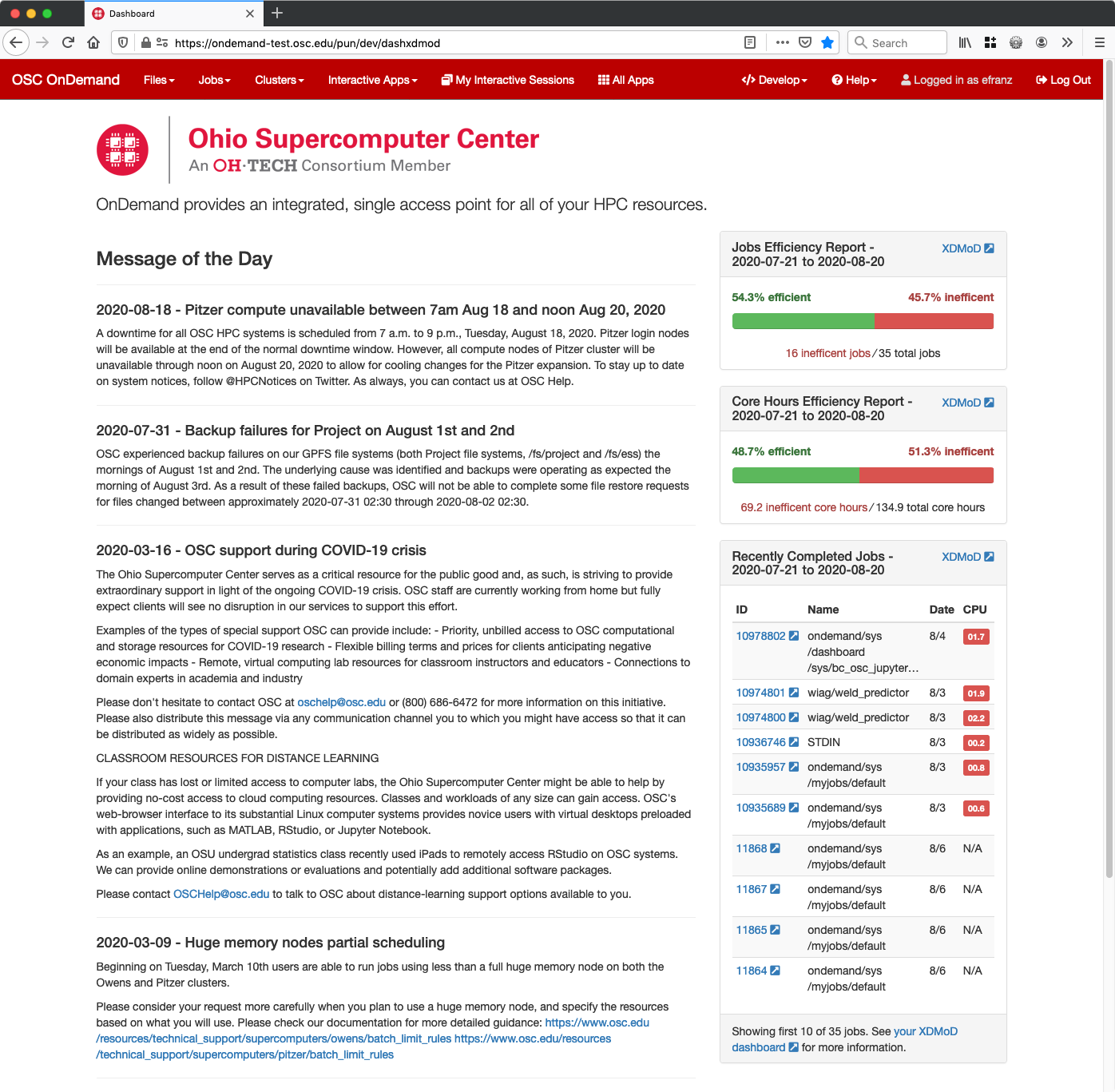
Fig. 5 Example of XDMoD Job Efficiency reports in the OnDemand Dashboard.¶
Steps to enable the XDMoD reports in the OnDemand Dashboard:
Configure OnDemand with XDMoD host URL in PUN /etc/ood/config/nginx_stage.yml
pun_custom_env: OOD_XDMOD_HOST: "https://xdmod.osc.edu"
Add OnDemand host as domain to XDMoD portal settings for CORS /etc/xdmod/portal_settings.ini
domains = "https://ondemand.osc.edu"
Configure identity provider to include OnDemand host in HTTP Content-Security-Policy for frame-ancestors since OnDemand uses iFrames to trigger SSO with XDMoD when a user logs in. Below is what we ensured Content-Security-Policy header for frame-ancestors was set to when configuring Keycloak:
frame-ancestors https://*.osc.edu 'self'
If you want the XDMoD links in the OnDemand Job Composer you also need to configure OnDemand with XDMoD resource id in each cluster config. For example, in the hpctoolset the resource_id for the hpc cluster is 1 in XDMoD, so we modify /etc/ood/config/clusters.d/hpc.yml to add a xdmod map to the custom map at the bottom of the file:
v2: metadata: title: "HPC Cluster" login: host: "frontend" job: adapter: "slurm" cluster: "hpc" bin: "/usr/bin" custom: xdmod: resource_id: 1
In the Job Composer, Open XDMoD job links will include a warning message that the job may not appear in XDMoD for up to 24 hours after the job completed. The message is to address the gap of time between the job appearing as completed in the Job Composer and the job appearing in Open XDMoD after the ingest and aggregation script is run. This message appears from the time the Job Composer becomes aware of the job completion status, till an elapsed time specified in seconds by the locale key
en.jobcomposer.xdmod_url_warning_message_seconds_after_job_completionwhich defaults to 24 hours (86400 seconds) with a text message specified by locale keyen.jobcomposer.xdmod_url_warning_message. To disable this message, set the value you your locale file under/etc/ood/config/locales. For example, in the default locale we have these values:en: jobcomposer: xdmod_url_warning_message: "This job may not appear in Open XDMoD until 24 hours after the completion of the job." xdmod_url_warning_message_seconds_after_job_completion: 86400
Which results in these warning messages appearing in Job Composer:

